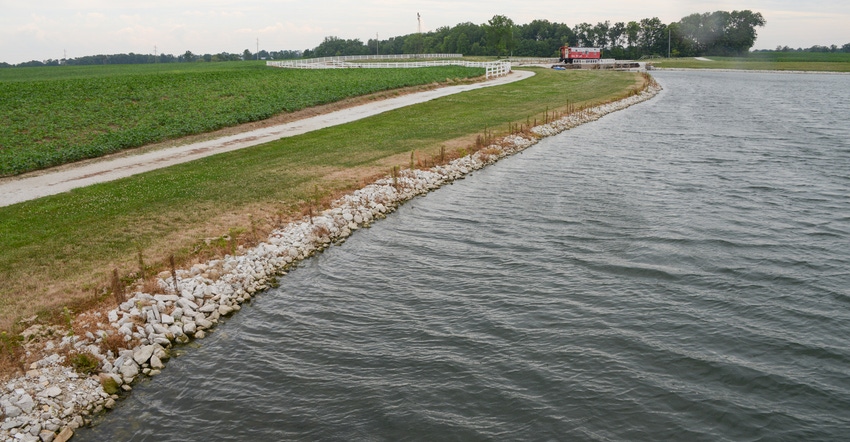October 31, 2018

By Steve Werblow
To check the health of the fields on Andy Shireman’s 2,400-acre operation near Chapin, Ill., take a look at his seven farm ponds. He originally built them to protect nearby streams from sediment flowing off the fields during storms; the ponds would act as settling basins so stormwater runoff would deposit the soil and nutrients it was carrying before it reached the creeks.
Years ago, it was clear that the ponds were doing their job, Shireman says, because they would steadily fill up with sediment.
“It used to be, a pond would last 20 years next to a field,” he recalls. After that, it was choked with runaway soil.
Now, the fact that the ponds themselves are clear illustrates something even more exciting — that sediment is no longer leaving the fields in the first place. Shireman credits that to his efforts to minimize runoff, combining no-till and strip till, cover crops, grassed buffer strips, and stormwater-holding dry dams.
“We have no sediment going into our ponds,” Shireman says. “We’ve gotten bigger rains than we ever used to. I had zero gullies washed. None. Everything had living roots, and there was material there for water to run over the top of, slowing it down and holding the sediment.”
Less flooding
Shireman adds that slowing the runoff and filtering out sediment on the field also keeps streams from flooding.
“When we get a great big rain, the creeks get time to flush out before all that water gets to them,” he explains. “It makes a big difference. We don’t flood like we used to.”
 PROOF: Andy Shireman says even though he’s seen bigger rains than he ever used to on his Chapin, Ill., farm, “I had zero gullies washed. None. Everything had living roots, and there was material there for water to run over the top of, slowing it down and holding the sediment.”
PROOF: Andy Shireman says even though he’s seen bigger rains than he ever used to on his Chapin, Ill., farm, “I had zero gullies washed. None. Everything had living roots, and there was material there for water to run over the top of, slowing it down and holding the sediment.”

Reducing sediment and nutrients entering streams with runoff makes a big difference to water quality, too. The U.S. Environmental Protection Agency’s National Aquatic Resource Survey (NARS) revealed that half of the river and stream miles in the temperate plains region — which includes Illinois, Indiana and flatlands from western Ohio up into the eastern Dakotas — rated fair or poor due to high sediment content. Almost half (46%) of the region’s streams rated poor for macroinvertebrate populations, which depend on clean, clear water for survival, and 65% of river and stream miles rated poor due to high nitrogen content.
Steve Paulsen at EPA’s National Health and Environmental Effects Research Laboratory in Corvallis, Ore., says the data on pollutants and macroinvertebrates point to a problem that farmers like Shireman are helping address through their conservation efforts.
“Over time, high sediment and nutrient losses have degraded water quality and habitat in rivers, lakes and even far downstream areas like the Gulf of Mexico,” Paulsen says. “Conservation efforts by farmers like Andy Shireman improve the quality of the runoff water entering local streams, and that in turn affects water quality all the way down to the Gulf.
“We are beginning our next round of National Rivers and Streams Assessment through NARS, and I am eager to see what the data will look like on sediment and water quality thanks to farmers across the landscape like Andy Shireman who have been planting cover crops and implementing other conservation practices on millions of acres.”

Shireman (left) notes that his bottom line depends on keeping soil and nutrients on his land.
“That’s mine. I paid for that,” he says. “I don’t want to see it going down to the Gulf of Mexico any more than any left-wing activist wants to. I want it on my farm. I will do anything to keep it there.”
Shireman says he dabbled in cover crops for a while before going all-in five years ago. He keeps it simple, drilling 30 pounds of cereal rye seed per acre where he wants to suppress marestail and waterhemp along with controlling erosion. He backs off to 15 pounds per acre where weed competition isn’t as great, and before corn.
Shireman isn’t the only one who’s happy with his program. He says landlords appreciate the fact that he’s improving their farms.
“They’re right along with me,” he says. “They want to do the right thing also.
“I have better relationships with the old farmers,” he points out. “They’re more into cover crops than the baby boomers because they used to do it. They might have had a four-crop rotation. They might have had clover as fertilizer for their corn.”
Some of those older farmers might enjoy spending a little time with Shireman down by one of his ponds. With their soil comfortably in place in the field under a lush canopy of soybeans or corn, Shireman’s clear water is great for a little crappie or bluegill fishing — even some bass.
For more information
EPA and its partners across the country are beginning a new round of sampling for the next NARS report. Meanwhile, farmers can access data from the most recent NARS reports on EPA’s website.
Werblow writes from Oregon.
You May Also Like




